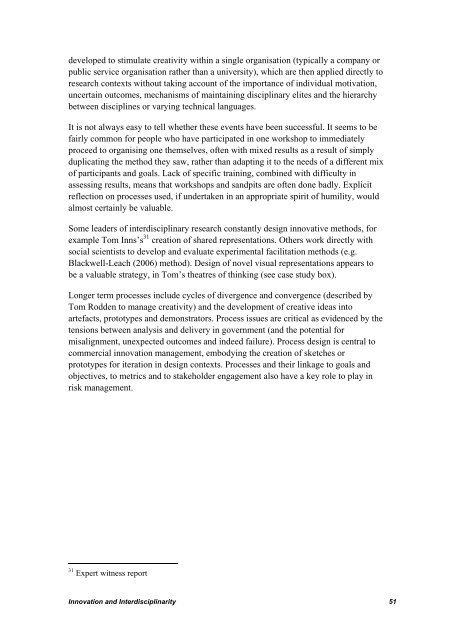Radical innovation: crossing knowledge boundaries with ...
Radical innovation: crossing knowledge boundaries with ...
Radical innovation: crossing knowledge boundaries with ...
You also want an ePaper? Increase the reach of your titles
YUMPU automatically turns print PDFs into web optimized ePapers that Google loves.
developed to stimulate creativity <strong>with</strong>in a single organisation (typically a company or<br />
public service organisation rather than a university), which are then applied directly to<br />
research contexts <strong>with</strong>out taking account of the importance of individual motivation,<br />
uncertain outcomes, mechanisms of maintaining disciplinary elites and the hierarchy<br />
between disciplines or varying technical languages.<br />
It is not always easy to tell whether these events have been successful. It seems to be<br />
fairly common for people who have participated in one workshop to immediately<br />
proceed to organising one themselves, often <strong>with</strong> mixed results as a result of simply<br />
duplicating the method they saw, rather than adapting it to the needs of a different mix<br />
of participants and goals. Lack of specific training, combined <strong>with</strong> difficulty in<br />
assessing results, means that workshops and sandpits are often done badly. Explicit<br />
reflection on processes used, if undertaken in an appropriate spirit of humility, would<br />
almost certainly be valuable.<br />
Some leaders of interdisciplinary research constantly design innovative methods, for<br />
example Tom Inns’s 31 creation of shared representations. Others work directly <strong>with</strong><br />
social scientists to develop and evaluate experimental facilitation methods (e.g.<br />
Blackwell-Leach (2006) method). Design of novel visual representations appears to<br />
be a valuable strategy, in Tom’s theatres of thinking (see case study box).<br />
Longer term processes include cycles of divergence and convergence (described by<br />
Tom Rodden to manage creativity) and the development of creative ideas into<br />
artefacts, prototypes and demonstrators. Process issues are critical as evidenced by the<br />
tensions between analysis and delivery in government (and the potential for<br />
misalignment, unexpected outcomes and indeed failure). Process design is central to<br />
commercial <strong>innovation</strong> management, embodying the creation of sketches or<br />
prototypes for iteration in design contexts. Processes and their linkage to goals and<br />
objectives, to metrics and to stakeholder engagement also have a key role to play in<br />
risk management.<br />
31 Expert witness report<br />
Innovation and Interdisciplinarity 51

















